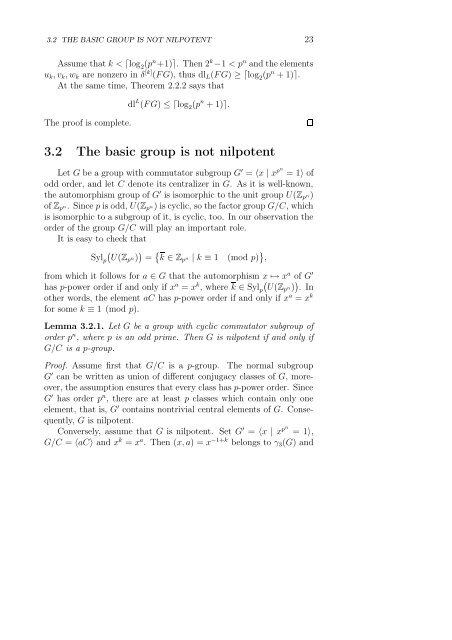On the Derived Length of Lie Solvable Group Algebras
On the Derived Length of Lie Solvable Group Algebras
On the Derived Length of Lie Solvable Group Algebras
You also want an ePaper? Increase the reach of your titles
YUMPU automatically turns print PDFs into web optimized ePapers that Google loves.
3.2 THE BASIC GROUP IS NOT NILPOTENT 23<br />
Assume that k < ⌈log 2(p n +1)⌉. Then 2 k −1 < p n and <strong>the</strong> elements<br />
uk, vk, wk are nonzero in δ [k] (F G), thus dlL(F G) ≥ ⌈log 2(p n + 1)⌉.<br />
At <strong>the</strong> same time, Theorem 2.2.2 says that<br />
The pro<strong>of</strong> is complete.<br />
dl L (F G) ≤ ⌈log 2(p n + 1)⌉.<br />
3.2 The basic group is not nilpotent<br />
Let G be a group with commutator subgroup G ′ = 〈x | xpn = 1〉 <strong>of</strong><br />
odd order, and let C denote its centralizer in G. As it is well-known,<br />
<strong>the</strong> automorphism group <strong>of</strong> G ′ is isomorphic to <strong>the</strong> unit group U(Zpn) <strong>of</strong> Zpn. Since p is odd, U(Zpn) is cyclic, so <strong>the</strong> factor group G/C, which<br />
is isomorphic to a subgroup <strong>of</strong> it, is cyclic, too. In our observation <strong>the</strong><br />
order <strong>of</strong> <strong>the</strong> group G/C will play an important role.<br />
It is easy to check that<br />
<br />
Sylp U(Zpn) = k ∈ Zpn | k ≡ 1 (mod p) ,<br />
from which it follows for a ∈ G that <strong>the</strong> automorphism x ↦→ xa <strong>of</strong> G ′<br />
has p-power order if and only if xa = xk <br />
, where k ∈ Sylp U(Zpn) . In<br />
o<strong>the</strong>r words, <strong>the</strong> element aC has p-power order if and only if xa = xk for some k ≡ 1 (mod p).<br />
Lemma 3.2.1. Let G be a group with cyclic commutator subgroup <strong>of</strong><br />
order p n , where p is an odd prime. Then G is nilpotent if and only if<br />
G/C is a p-group.<br />
Pro<strong>of</strong>. Assume first that G/C is a p-group. The normal subgroup<br />
G ′ can be written as union <strong>of</strong> different conjugacy classes <strong>of</strong> G, moreover,<br />
<strong>the</strong> assumption ensures that every class has p-power order. Since<br />
G ′ has order pn , <strong>the</strong>re are at least p classes which contain only one<br />
element, that is, G ′ contains nontrivial central elements <strong>of</strong> G. Consequently,<br />
G is nilpotent.<br />
Conversely, assume that G is nilpotent. Set G ′ = 〈x | xpn = 1〉,<br />
G/C = 〈aC〉 and xk = xa . Then (x, a) = x−1+k belongs to γ3(G) and


